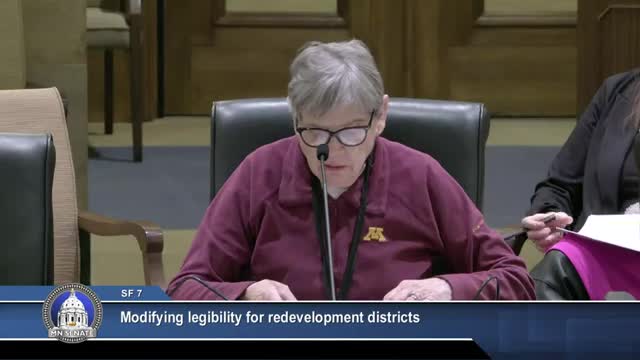Senate committee debates tax-increment financing changes; author proposes shortening redevelopment districts to 20 years
February 18, 2025 | 2025 Legislature MN, Minnesota
This article was created by AI summarizing key points discussed. AI makes mistakes, so for full details and context, please refer to the video of the full meeting. Please report any errors so we can fix them. Report an error »

Senate File 7, presented Feb. 18 by Senator Rest, would revise Minnesota's tax-increment financing (TIF) law by adopting a less-restrictive blight test for redevelopment districts, eliminating stand-alone renovation and renewal districts, and reducing the default duration for redevelopment districts from 25 years to 20 years.
Senator Rest said the bill aims to reduce the number of special "notwithstanding" bills that cities bring to the Legislature because a 20th-century definition of "blight" no longer fits many modern redevelopment projects. "The goal is not for it to last forever," Senator Rest said, describing the intent that improved property return to the tax rolls once projects are completed.
Stacy Quilvang, a municipal advisor who works with cities on TIF creation, told the committee that while many cities decertify districts early, shortening the default duration could harm communities that legitimately need the full 25-year period for complex redevelopment: "There really isn't a council that wants to have a district that goes on forever and ever. So everyone's goal is to get the goals of the redevelopment done and get that back on the tax rolls as soon as possible," Quilvang said. She urged retaining the 25-year option and suggested targeted statutory changes instead of broad duration reductions.
Quilvang and other witnesses provided several data points to the committee: there are roughly 1,600 TIF districts in Minnesota, about 700 of which are redevelopment districts; only 18 are renovation and renewal districts. Since 1988 there have been about 224 special-legislation requests related to TIF; excluding technical or repealed bills, approximately 197 requests (an average of five to six per year). Quilvang also asked the legislature to consider extending the five-year rule (which limits when increment must be obligated) to 10 years, a change proposed elsewhere (Senate File 585) and long-requested by cities.
Committee members pressed concerns about the proposed 20-year limit given current economic uncertainty and potential declines in commercial property values that could extend project timelines. Senator Reisman said he was open to discussing the duration limit with colleagues, and Senator Webb expressed concern that shorter durations could penalize projects during prolonged economic downturns.
Senate File 7 was laid over for possible inclusion; authors and witnesses said they will continue to confer with city leaders and auditors on technical changes.
Senator Rest said the bill aims to reduce the number of special "notwithstanding" bills that cities bring to the Legislature because a 20th-century definition of "blight" no longer fits many modern redevelopment projects. "The goal is not for it to last forever," Senator Rest said, describing the intent that improved property return to the tax rolls once projects are completed.
Stacy Quilvang, a municipal advisor who works with cities on TIF creation, told the committee that while many cities decertify districts early, shortening the default duration could harm communities that legitimately need the full 25-year period for complex redevelopment: "There really isn't a council that wants to have a district that goes on forever and ever. So everyone's goal is to get the goals of the redevelopment done and get that back on the tax rolls as soon as possible," Quilvang said. She urged retaining the 25-year option and suggested targeted statutory changes instead of broad duration reductions.
Quilvang and other witnesses provided several data points to the committee: there are roughly 1,600 TIF districts in Minnesota, about 700 of which are redevelopment districts; only 18 are renovation and renewal districts. Since 1988 there have been about 224 special-legislation requests related to TIF; excluding technical or repealed bills, approximately 197 requests (an average of five to six per year). Quilvang also asked the legislature to consider extending the five-year rule (which limits when increment must be obligated) to 10 years, a change proposed elsewhere (Senate File 585) and long-requested by cities.
Committee members pressed concerns about the proposed 20-year limit given current economic uncertainty and potential declines in commercial property values that could extend project timelines. Senator Reisman said he was open to discussing the duration limit with colleagues, and Senator Webb expressed concern that shorter durations could penalize projects during prolonged economic downturns.
Senate File 7 was laid over for possible inclusion; authors and witnesses said they will continue to confer with city leaders and auditors on technical changes.
View full meeting
This article is based on a recent meeting—watch the full video and explore the complete transcript for deeper insights into the discussion.
View full meeting
